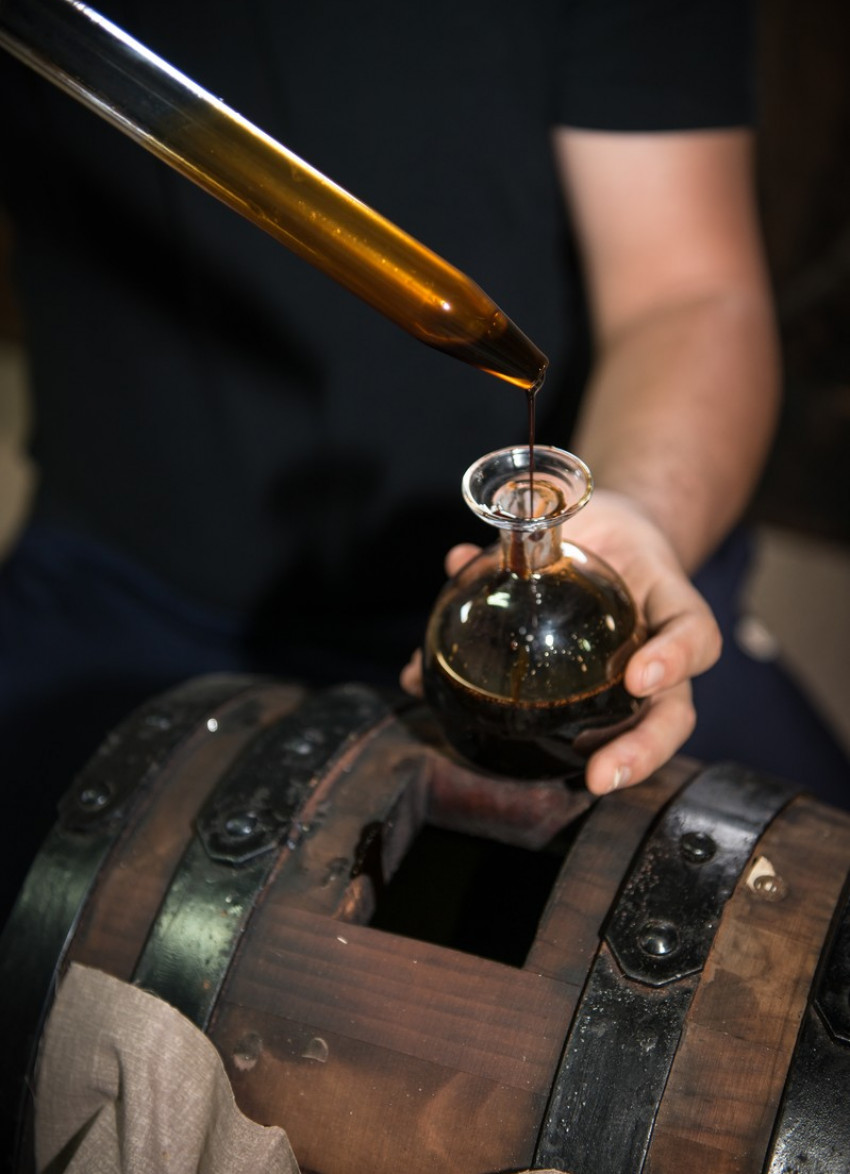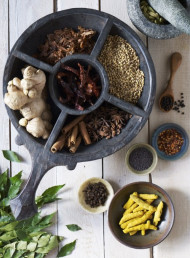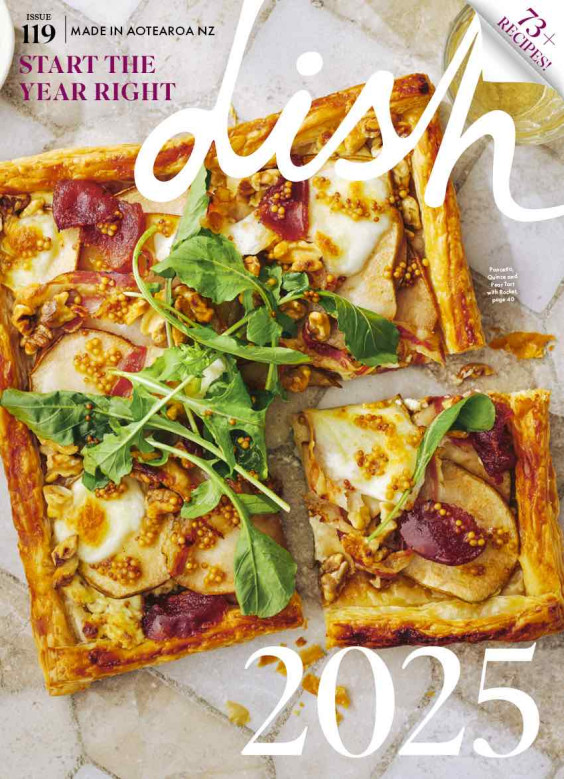Cooking with: balsamic vinegar

Balsamic vinegar is a complexly flavoured condiment with different uses in cooking, depending on its age and quality. It’s also central to agrodolce – a much used cooking technique perfected in Italy.
A dark, richand roundly flavoured condiment, balsamic vinegar was once considered the black gold of Modena.
Balsamic is essentially cooked and barrel-aged grape-must (freshly pressed grape juice). Instead of allowing the must to sour, as when processing most vinegars, the must of balsamic vinegar is cooked for 36 hours and then aged in a series of barrels ranging in size and wood type. As it ages, it picks up various flavours from each of the wooden barrels in which it spends time. It starts life in a large barrel, where it is blended with 25 per cent of the must from a previous harvest. As it evaporates it is decanted into smaller barrels made of different wood and is again mixed to approximately a 3:1 ratio of new to old must. While it is aging it spends time in barrels made of local chestnut, cherry, oak, juniper and mulberry woods, some of which are more than a century old. The more transferences that occur the more dynamic and complex the flavours become. Each year it is sampled for taste and texture.
Balsamic has been made in the Modena and Reggio Emilia regions since the Middle Ages.
There are three different types of balsamic vinegar each varying in style, production and use. The highest quality balsamic vinegars made in the traditional way are protected by both the Italian and the European Union’s Protected Designation of Origin or DOP.
Balsamic has been made in the Modena and Reggio Emilia regions since the Middle Ages. Vinegars made in Modena are labeled as Aceto Balsamico Tradizionale di Modena (Traditional Balsamic Vinegar of Modena) and those made in Reggio Emilia are denoted as Aceto Balsamico Tradizionale di Reggio Emilia (Traditional Balsamic Vinegar of Reggio Emilia). To be classified with this elite status the producers must follow strict rules with the production and flavour profiles and the vinegar must be aged for a minimum of 12 years. These are the finest and most expensive balsamic vinegars.
Fondly referred to as Tradizionale, they are fairly thick, very rich in flavour and therefore, should be used sparingly and not just as a condiment. They should have equal importance to the foods they are being served with and should never be cooked. They are best used with simple dishes so that their sweet, rich flavour can shine.
Cesare Casella, Dean of the Italian Culinary Experience in Parma, Italy and New York City says, “Use it in a stingy way. It is expensive and you only need a drop. And never use it in a dressing.” Elevate an antipasto platter to a whole new level by placing a few drops to the top of mortadella or Parmigianno cheese. Add a few drops to the top of a cooked steak or grilled fish and when paired with fresh strawberries, balsamic brings out both the sweetness and slight acidity. It can also be used as a digestive by placing a few drops in sparkling water. This liquid gold is a case of less is more, so use it drop by drop.
The Condimento grade vinegars are made in Modena and Reggio Emilia, as well as other regions. They are not required to be aged for 12 years and are often mixed with reduced grape juice. While these vinegars are slightly lower in quality than the Tradizionale, they are very rich in flavour and texture and are also not as expensive. Bottles are stamped with an Indicazione Geografica Protetta (Protected Geographical Indication or IGP) label for classification. They should be treated as an important part of the dish.
Unlike their expensive Tradizionale counterparts, Condimento vinegars can be heated, but should not be cooked for long periods. They can be added to sauces to brighten the flavour or to deglaze a pan after cooking meat (pork chops, veal scallopini and even fish) and then spooned over the meat. Or drizzle over new potatoes garnished with parsley.
If a bottle is labelled Balsamic Vinegar of Modena, it is typically produced on a larger scale than either the Tradizionale or Condimento vinegars and is therefore also the least expensive. These are normally un-aged, or mixed with small amounts of an aged vinegar. Widely available in supermarkets, this is the balsamic that most of us will have in our pantries.
Use this type of balsamic for marinades, dips, salad dressings and sauces. Because they are aged less, they are normally thinner and more acidic than the Tradizionale or Condimento. This makes them perfect for cooking as reducing them also strengthens their flavour. If a recipe calls for wine, then it can be partially replaced by balsamic. It makes for delicious pickled onions and vegetables.
A very popular way to use Balsamic Vinegar of Modena is in agrodolce. A much used and loved cooking technique in Italy, agro (sour) and dolce (sweet) elements are combined and reduced, then served with fish, chicken, pork, beef or lamb.
There are two types of agrodolce, one from the north and one from the south of Italy. Both are the same in concept yet vary slightly in practice. Agrodolce from the north uses balsamic vinegar and, because of its sweetness, requires a nominal amount of sugar. The southern style uses an acidic vinegar such as red or white wine vinegar which requires a significant amount of sugar to make it palatable. The techniques from both regions combine vinegar, sugar, water, spices and sometimes wine which are slowly simmered until the sauce has thickened and becomes glaze-like. The flavours can be enhanced by adding shallots, onions or fruit such as plums, peaches, mangoes or blueberries. This sauce stores superbly in the refrigerator for up to two weeks, so can be kept on hand when preparing dinner in a hurry.
Balsamic vinegar, regardless of type, is an adaptable condiment that can be used for every course of a meal from start to finish.
latest issue:
Issue #119
Welcome to 2025 and a brand-new year of whipping up delicious recipe withdish! We start the year right with issue 119, jam-packed with easy, mouthwatering meals to make at home. From stunning salads to quick and tasty one-pan chicken dishes, to spectacular sweet treats. We have duos covered with our dinners for two, plenty of wonderful recipes for easy flavour-packed entertaining and make the most of the abundance of fresh seasonal produce. We finish off with a whistle-stop tour of South Australia’s wine country and a round-up of our top tipples from 2024. The latest issue of dish is on sale NOW at all good bookstores and supermarkets – don’t miss it!





